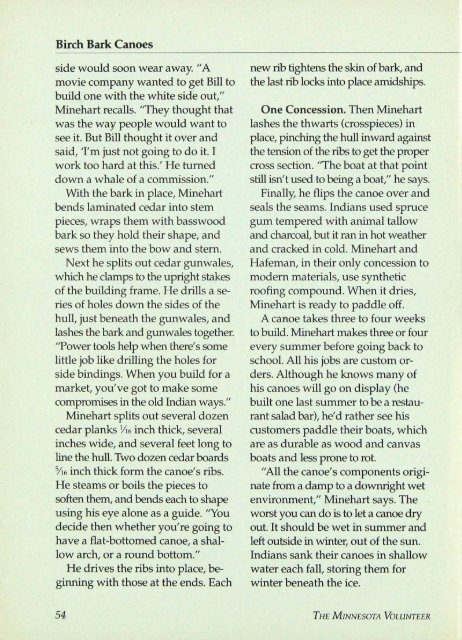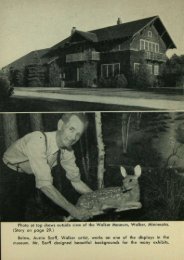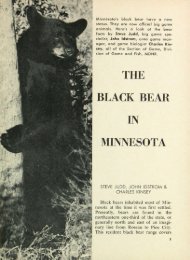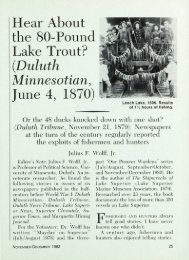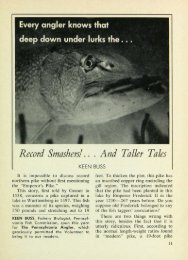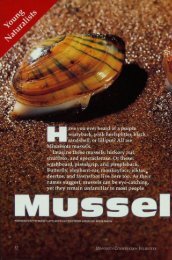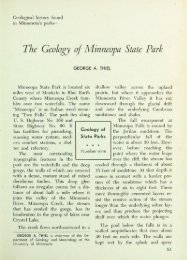282 Building the Bark Canoe - webapps8
282 Building the Bark Canoe - webapps8
282 Building the Bark Canoe - webapps8
- No tags were found...
Create successful ePaper yourself
Turn your PDF publications into a flip-book with our unique Google optimized e-Paper software.
Birch <strong>Bark</strong> <strong>Canoe</strong>sside would soon wear away. "Amovie company wanted to get Bill tobuild one with <strong>the</strong> white side out,"Minehart recalls. "They thought thatwas <strong>the</strong> way people would want tosee it. But Bill thought it over andsaid, 'I'm just not going to do it. Iwork too hard at this.' He turneddown a whale of a commission."With <strong>the</strong> bark in place, Minehartbends laminated cedar into stempieces, wraps <strong>the</strong>m with basswoodbark so <strong>the</strong>y hold <strong>the</strong>ir shape, andsews <strong>the</strong>m into <strong>the</strong> bow and stern.Next he splits out cedar gunwales,which he clamps to <strong>the</strong> upright stakesof <strong>the</strong> building frame. He drills a seriesof holes down <strong>the</strong> sides of <strong>the</strong>hull, just beneath <strong>the</strong> gunwales, andlashes <strong>the</strong> bark and gunwales toge<strong>the</strong>r.'Tower tools help when <strong>the</strong>re's somelittle job like drilling <strong>the</strong> holes forside bindings. When you build for amarket, you've got to make somecompromises in <strong>the</strong> old Indian ways."Minehart splits out several dozencedar planks Vi6 inch thick, severalinches wide, and several feet long toline <strong>the</strong> hull. Two dozen cedar boards5/i6 inch thick form <strong>the</strong> canoe's ribs.He steams or boils <strong>the</strong> pieces tosoften <strong>the</strong>m, and bends each to shapeusing his eye alone as a guide. "Youdecide <strong>the</strong>n whe<strong>the</strong>r you're going tohave a flat-bottomed canoe, a shallowarch, or a round bottom."He drives <strong>the</strong> ribs into place, beginningwith those at <strong>the</strong> ends. Eachnew rib tightens <strong>the</strong> skin of bark, and<strong>the</strong> last rib locks into place amidships.One Concession. Then Minehartlashes <strong>the</strong> thwarts (crosspieces) inplace, pinching <strong>the</strong> hull inward against<strong>the</strong> tension of <strong>the</strong> ribs to get <strong>the</strong> propercross section. "The boat at that pointstill isn't used to being a boat," he says.Finally, he flips <strong>the</strong> canoe over andseals <strong>the</strong> seams. Indians used sprucegum tempered with animal tallowand charcoal, but it ran in hot wea<strong>the</strong>rand cracked in cold. Minehart andHafeman, in <strong>the</strong>ir only concession tomodern materials, use syn<strong>the</strong>ticroofing compound. When it dries,Minehart is ready to paddle off.A canoe takes three to four weeksto build. Minehart makes three or fourevery summer before going back toschool. All his jobs are custom orders.Although he knows many ofhis canoes will go on display (hebuilt one last summer to be a restaurantsalad bar), he'd ra<strong>the</strong>r see hiscustomers paddle <strong>the</strong>ir boats, whichare as durable as wood and canvasboats and less prone to rot."All <strong>the</strong> canoe's components originatefrom a damp to a downright wetenvironment," Minehart says. Theworst you can do is to let a canoe dryout. It should be wet in summer andleft outside in winter, out of <strong>the</strong> sun.Indians sank <strong>the</strong>ir canoes in shallowwater each fall, storing <strong>the</strong>m forwinter beneath <strong>the</strong> ice.54 THE MINNESOTA VOLUNTEER


